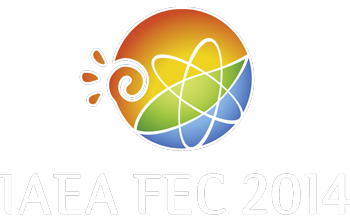Speaker
Dr
Yusuke Kosuga
(Institute for Advanced Study, Kyushu University)
Description
Predictive modeling of turbulent transport is essential to the success of ITER and DEMO. Due to the collisionless nature of fusion plasmas, turbulence with strong wave-particle interaction – such as collisionless trapped electron or ion modes (CTEM/CTIM) or energetic particle (EP) modes – can develop in fusion plasmas. However, transport caused by these turbulence cannot be described by the conventional quasilinear transport analysis. This is since the precession resonance allows a long correlation time between resonant trapped particles and fluctuations to produce a group of correlated resonant trapped particles, called granulations. In the presence of granulations, transport is not determined by quasilinear diffusion, but by Lenard-Balescu flux with Fokker-Planck drag. In this paper, we report progress on the modeling of turbulent transport caused by trapped ion granulations.
In the first part of the work, we present application of transport caused by trapped ion granulations to the problem of toroidal momentum transport. In this part, we show that residual stress, which is a part of momentum flux that is not proportional to the velocity or velocity shear, can arise from momentum flux carried by trapped ion granulations. We discuss that this process can be viewed as a conversion of poloidal and toroidal momentum via trapped ion granulations. As an application to tokamak phenoemenology, we consider plasmas at L-H transiton, where poloidal ExB flows are accelerated. This acceleration can be converted to toroidal acceeration via the mechanism presented here. For typical parameters at the top of the pedestal of medium size tokamaks, we quantitatively find that this process can accelerate toroidal flows up to thermal Mach number ~0.1.
In the second part of the work, we discuss the feedback mechanism from macroscopic flows to microscopic turbulence with trapped ion granulations. We discuss extension of Biglari-Diamond-Terry mechanism of turbulence suppression by shear flows to the problem of turbulence with degree of freedom in velocity space, in order to account for the effect on trapped ion granulations. We show that energy dependent trapped ion precession enters decorrelation process, in addition to conventional ExB scattering and shearing.
| Country or International Organisation | Japan |
|---|---|
| Paper Number | TH/P2-14 |
Author
Dr
Yusuke Kosuga
(Institute for Advanced Study, Kyushu University)
Co-authors
Prof.
Kimitaka Itoh
(NIFS)
Dr
Maxime Lesur
(NFRI)
Prof.
Patrick H. Diamond
(NFRI, UCSD)
Prof.
Sanae Itoh
(Research Institute for Applied Mechanics, Kyushu University)

